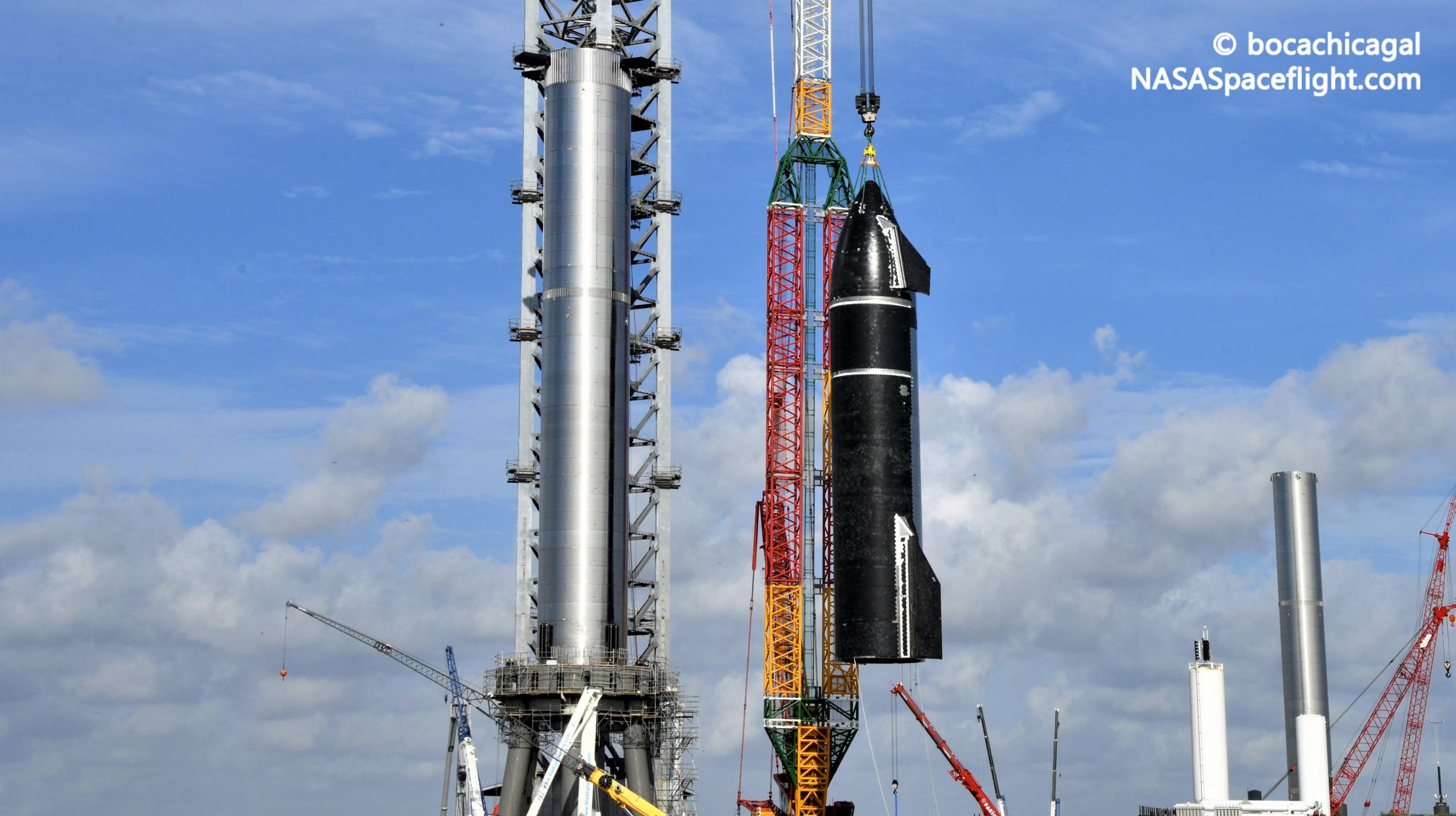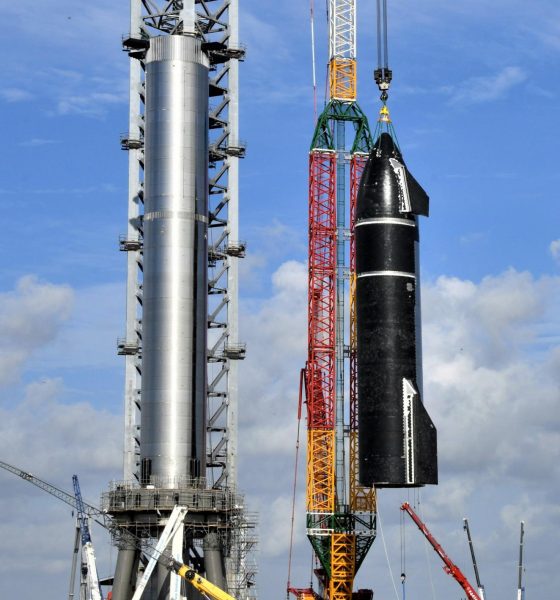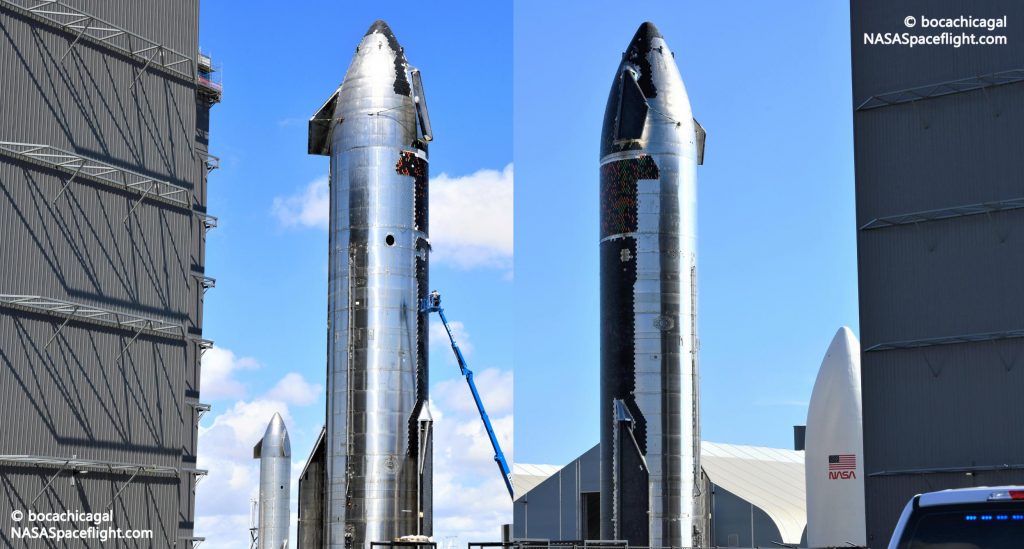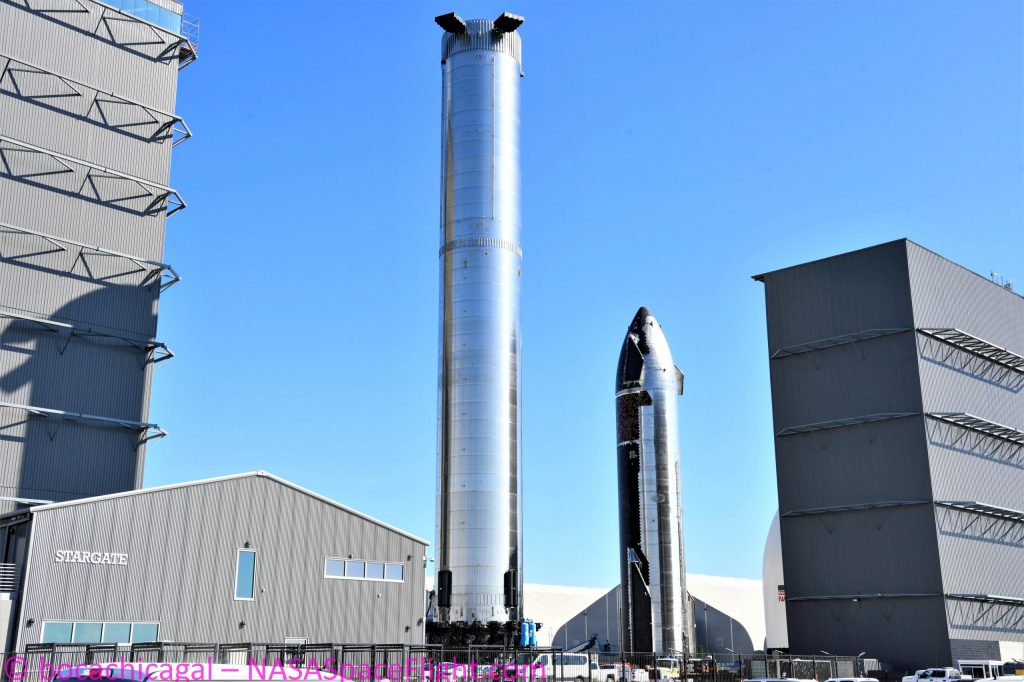

News
SpaceX’s first orbital-class Starship and Super Heavy to return to launch pad next week
CEO Elon Musk says that SpaceX could return the first orbital-class Starship prototype and its Super Heavy booster to the launch site after rolling the rockets back to the factory for finishing steps.
In response to a video of Super Heavy Booster 4 (B4) returning to the build site, Musk rather specifically stated that both Booster for and Starship 20 (S20) will return to the orbital launch pad on Monday, August 16th. SpaceX returned Ship 20 to its ‘high bay’ vertical integration facility mere hours after the Starship was stacked atop a Super Heavy booster (B4) for the first time ever on August 6th. For unknown reasons, perhaps due to high winds, Booster 4 spent another five days at the pad before SpaceX finally lifted it off the orbital launch mount and rolled it back to the high bay, where it took Ship 20’s place on August 11th.
Almost immediately after S20’s August 6th return, its six Raptor engines were removed to make way for an engine-less proof test campaign that Musk has now implied could start as early as next Monday. Mirroring S20, SpaceX also begin uninstalling Super Heavy Booster 4’s 29 Raptor engines the same day it returned to the high bay.
Around 12 hours after the process began, SpaceX appeared to have removed 14 (just shy of half) of Super Heavy B4’s Raptor engines – a pace almost as spectacular as their 12-18 hour installation a bit less than two weeks prior. Aside from making engine removal dramatically easier, Musk says that SpaceX moved Ship 20 and Booster 4 back to the build site to expedite some minor final integration work – namely “small plumbing and wiring.”
However, aside from Raptor removal, the most obvious and significant work ongoing since the pair’s return to the high bay is the process of inspecting Starship S20’s heat shield and repairing or replacing broken, chipped, and loose tiles. Not long after Ship 20 arrived back at the build site, workers in boom lifts began a seemingly arduous process of inspecting the Starship’s nose heat shield and marking – with colored tape – hundreds of tiles with cracks, chips, or other less visible issues.
After several days of inspections and hundreds of tiles marked, SpaceX finally began the process of removing off-nominal tiles early on August 12th. According to NASASpaceflight.com, that removal process is not particularly easy and can require the use of power tools to effectively cut tiles off their embedded mounting frames. Given the amount of force required, some level of care is also almost certainly needed to avoid damaging any adjacent tiles, which could quickly cause a minor misstep to exponentially spread. Nevertheless, a small team of SpaceX technicians seemingly managed to remove no less than several dozen (and maybe 100+) broken tiles in a few hours.

Up next, those removed tiles will need to be replaced. Still, it remains to be seen if SpaceX will choose to fully complete Starship S20’s “98% done” heat shield before sending the ship back to the launch site for proof and static fire testing. To a degree, putting Starship through a gauntlet of ground tests with a full heat shield installed would be an excellent test of the resilience of its thermal protection system to major thermal stresses from frosty steel skin and expansion/contraction during fueling, as well as violent vibrations during static fires.
However, Starship S20’s heat shield is already so close to completion that it might be only marginally less valuable to save time by testing the vehicle as soon as possible.

To an extent, Booster 4 is a much simpler case as Super Heavy needs to major thermal protection. However, according to Musk, some or all of Super Heavy’s 29 Raptor engines will need their own miniature thermal protection system – perhaps a flexible blanket-like enclosure not unlike what SpaceX uses to partially protect Falcon booster engines during reentry. It remains to be seen if Booster 4 will return to the launch site without engines for cryogenic proof testing or if SpaceX will install heat shielded Raptors before starting the first flightworthy Super Heavy’s first test campaign.

Elon Musk
Elon Musk’s X will start using a Tesla-like software update strategy
The initiative seems designed to accelerate updates to the social media platform, while maintaining maximum transparency.

Elon Musk’s social media platform X will adopt a Tesla-esque approach to software updates for its algorithm.
The initiative seems designed to accelerate updates to the social media platform, while maintaining maximum transparency.
X’s updates to its updates
As per Musk in a post on X, the social media company will be making a new algorithm to determine what organic and advertising posts are recommended to users. These updates would then be repeated every four weeks.
“We will make the new 𝕏 algorithm, including all code used to determine what organic and advertising posts are recommended to users, open source in 7 days. This will be repeated every 4 weeks, with comprehensive developer notes, to help you understand what changed,” Musk wrote in his post.
The initiative somewhat mirrors Tesla’s over-the-air update model, where vehicle software is regularly refined and pushed to users with detailed release notes. This should allow users to better understand the details of X’s every update and foster a healthy feedback loop for the social media platform.
xAI and X
X, formerly Twitter, has been acquired by Elon Musk’s artificial intelligence startup, xAI last year. Since then, xAI has seen a rapid rise in valuation. Following the company’s the company’s upsized $20 billion Series E funding round, estimates now suggest that xAI is worth tens about $230 to $235 billion. That’s several times larger than Tesla when Elon Musk received his controversial 2018 CEO Performance Award.
As per xAI, the Series E funding round attracted a diverse group of investors, including Valor Equity Partners, Stepstone Group, Fidelity Management & Research Company, Qatar Investment Authority, MGX, and Baron Capital Group, among others. Strategic partners NVIDIA and Cisco Investments also continued support for building the world’s largest GPU clusters.
News
Tesla FSD Supervised wins MotorTrend’s Best Driver Assistance Award
The decision marks a notable reversal for the publication from prior years, with judges citing major real-world improvements that pushed Tesla’s latest FSD software ahead of every competing ADAS system.

Tesla’s Full Self-Driving (Supervised) system has been named the best driver-assistance technology on the market, earning top honors at the 2026 MotorTrend Best Tech Awards.
The decision marks a notable reversal for the publication from prior years, with judges citing major real-world improvements that pushed Tesla’s latest FSD software ahead of every competing ADAS system. And it wasn’t even close.
MotorTrend reverses course
MotorTrend awarded Tesla FSD (Supervised) its 2026 Best Tech Driver Assistance title after extensive testing of the latest v14 software. The publication acknowledged that it had previously criticized earlier versions of FSD for erratic behavior and near-miss incidents, ultimately favoring rivals such as GM’s Super Cruise in earlier evaluations.
According to MotorTrend, the newest iteration of FSD resolved many of those shortcomings. Testers said v14 showed far smoother behavior in complex urban scenarios, including unprotected left turns, traffic circles, emergency vehicles, and dense city streets. While the system still requires constant driver supervision, judges concluded that no other advanced driver-assistance system currently matches its breadth of capability.
Unlike rival systems that rely on combinations of cameras, radar, lidar, and mapped highways, Tesla’s FSD operates using a camera-only approach and is capable of driving on city streets, rural roads, and freeways. MotorTrend stated that pure utility, the ability to handle nearly all road types, ultimately separated FSD from competitors like Ford BlueCruise, GM Super Cruise, and BMW’s Highway Assistant.
High cost and high capability
MotorTrend also addressed FSD’s pricing, which remains significantly higher than rival systems. Tesla currently charges $8,000 for a one-time purchase or $99 per month for a subscription, compared with far lower upfront and subscription costs from other automakers. The publication noted that the premium is justified given FSD’s unmatched scope and continuous software evolution.
Safety remained a central focus of the evaluation. While testers reported collision-free operation over thousands of miles, they noted ongoing concerns around FSD’s configurable driving modes, including options that allow aggressive driving and speeds beyond posted limits. MotorTrend emphasized that, like all Level 2 systems, FSD still depends on a fully attentive human driver at all times.
Despite those caveats, the publication concluded that Tesla’s rapid software progress fundamentally reshaped the competitive landscape. For drivers seeking the most capable hands-on driver-assistance system available today, MotorTrend concluded Tesla FSD (Supervised) now stands alone at the top.
News
Elon Musk’s Grokipedia surges to 5.6M articles, almost 79% of English Wikipedia
The explosive growth marks a major milestone for the AI-powered online encyclopedia, which was launched by Elon Musk’s xAI just months ago.

Elon Musk’s Grokipedia has grown to an impressive 5,615,201 articles as of today, closing in on 79% of the English Wikipedia’s current total of 7,119,376 articles.
The explosive growth marks a major milestone for the AI-powered online encyclopedia, which was launched by Elon Musk’s xAI just months ago. Needless to say, it would only be a matter of time before Grokipedia exceeds English Wikipedia in sheer volume.
Grokipedia’s rapid growth
xAI’s vision for Grokipedia emphasizes neutrality, while Grok’s reasoning capabilities allow for fast drafting and fact-checking. When Elon Musk announced the initiative in late September 2025, he noted that Grokipedia would be an improvement to Wikipedia because it would be designed to avoid bias.
At the time, Musk noted that Grokipedia “is a necessary step towards the xAI goal of understanding the Universe.”
Grokipedia was launched in late October, and while xAI was careful to list it only as Version 0.1 at the time, the online encyclopedia immediately earned praise. Wikipedia co-founder Larry Sanger highlighted the project’s innovative approach, noting how it leverages AI to fill knowledge gaps and enable rapid updates. Netizens also observed how Grokipedia tends to present articles in a more objective manner compared to Wikipedia, which is edited by humans.
Elon Musk’s ambitious plans
With 5,615,201 total articles, Grokipedia has now grown to almost 79% of English Wikipedia’s article base. This is incredibly quick, though Grokipedia remains text-only for now. xAI, for its part, has now updated the online encyclopedia’s iteration to v0.2.
Elon Musk has shared bold ideas for Grokipedia, including sending a record of the entire knowledge base to space as part of xAI’s mission to preserve and expand human understanding. At some point, Musk stated that Grokipedia will be renamed to Encyclopedia Galactica, and it will be sent to the cosmos.
“When Grokipedia is good enough (long way to go), we will change the name to Encyclopedia Galactica. It will be an open source distillation of all knowledge, including audio, images and video. Join xAI to help build the sci-fi version of the Library of Alexandria!” Musk wrote, adding in a later post that “Copies will be etched in stone and sent to the Moon, Mars and beyond. This time, it will not be lost.”








